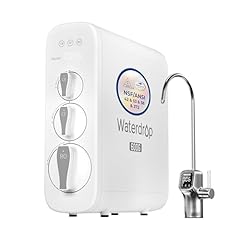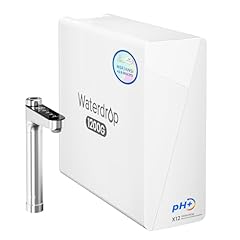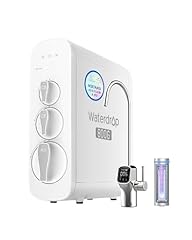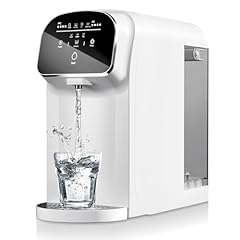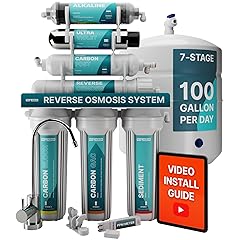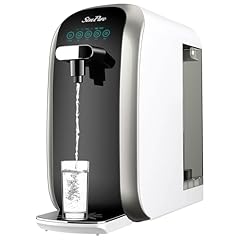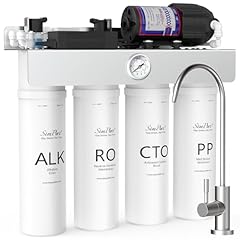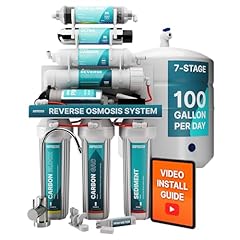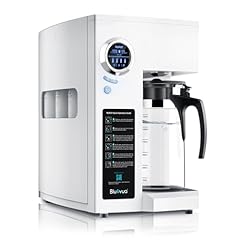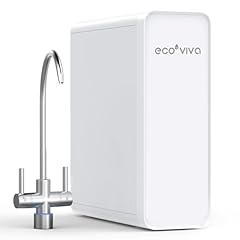-
1
Best Overall Highly efficient 2:1 pure to drain ratio
Highly efficient 2:1 pure to drain ratio Smart LED faucet enhances usability
Smart LED faucet enhances usability Tankless design saves space under sink
Tankless design saves space under sink -
2
 1200 GPD fast flow for high water demand.
1200 GPD fast flow for high water demand. 11-stage filtration ensures superior water purity.
11-stage filtration ensures superior water purity. Alkaline mineral addition improves water quality.
Alkaline mineral addition improves water quality. -
3
 Fast 800 GPD water flow rate
Fast 800 GPD water flow rate Tankless design saves under-sink space
Tankless design saves under-sink space Smart faucet with LED purifier
Smart faucet with LED purifier -
4
Hot Deal Easy to set up with no installation.
Easy to set up with no installation. High water efficiency with 5:1 pure to drain ratio.
High water efficiency with 5:1 pure to drain ratio. Built-in UV filter for extra purification.
Built-in UV filter for extra purification. -
5
 7-stage filtration ensures ultra-pure, great-tasting water.
7-stage filtration ensures ultra-pure, great-tasting water. Easy to install under sink with included faucet.
Easy to install under sink with included faucet. UV light eliminates bacteria for safer drinking water.
UV light eliminates bacteria for safer drinking water. -
6
Popular No installation needed, easy to set up.
No installation needed, easy to set up. High 4:1 pure to drain water ratio.
High 4:1 pure to drain water ratio. Certified for safety and efficiency.
Certified for safety and efficiency. -
7
 Provides pH+ remineralized water for better taste.
Provides pH+ remineralized water for better taste. Tankless design saves space under the sink.
Tankless design saves space under the sink. Built-in UV sterilization ensures cleaner water.
Built-in UV sterilization ensures cleaner water. -
8
 Offers 7-stage filtration for enhanced water purity.
Offers 7-stage filtration for enhanced water purity. Includes UV light for additional sterilization.
Includes UV light for additional sterilization. Remineralizes water for improved taste and health.
Remineralizes water for improved taste and health. -
9
 User-friendly countertop setup with no installation required.
User-friendly countertop setup with no installation required. 6-stage purification ensures exceptionally clean water.
6-stage purification ensures exceptionally clean water. Portable design perfect for home or office use.
Portable design perfect for home or office use. -
10
Best Affordable Efficient 8-stage filtration ensures pure water.
Efficient 8-stage filtration ensures pure water. Tankless design saves space under the sink.
Tankless design saves space under the sink. Filter life monitor helps track replacements easily.
Filter life monitor helps track replacements easily.
Overview of Reverse Osmosis System For Home
In today's world, ensuring access to clean and safe drinking water is more important than ever. Many homeowners are turning to reverse osmosis systems to enhance their water quality. These systems effectively remove contaminants, including chemicals, heavy metals, and sediments, providing crisp and refreshing water straight from the tap. With concerns over water pollution and aging infrastructure, having a reliable purification method at home offers peace of mind. Whether you're looking to improve water taste, safeguard your family's health, or reduce reliance on bottled water, a reverse osmosis system can be a valuable addition to your household.Top Reverse Osmosis System For Home
• Waterdrop G3 Tankless Reverse Osmosis System• Waterdrop X12 1200 GPD Tankless RO System• Waterdrop G3P800 Tankless RO SystemFAQ
Q: How does a reverse osmosis system for home improve water quality?
A: A reverse osmosis system for home significantly enhances water quality by removing impurities like chlorine, lead, and other contaminants. This process ensures that the water you drink and use for cooking is cleaner, safer, and tastes better, giving you peace of mind about your family's health.
Q: Is a reverse osmosis system for home energy-efficient?
A: Yes, a reverse osmosis system for home is energy-efficient as it relies on water pressure rather than electricity to filter out contaminants. This makes it an eco-friendly choice that can reduce your household's energy consumption while providing high-quality water.
Q: Can a reverse osmosis system for home remove hard water minerals?
A: While a reverse osmosis system for home can remove some hard water minerals, it is not specifically designed to soften water. It effectively reduces dissolved salts and impurities, but for comprehensive hard water treatment, pairing it with a water softener might be necessary.
Q: How long does it take to install a reverse osmosis system for home?
A: Installing a reverse osmosis system for home typically takes a few hours and can often be done as a DIY project if you're handy. However, for a seamless installation and to ensure optimal performance, you might consider hiring a professional plumber.
Q: Are there any ongoing costs associated with a reverse osmosis system for home?
A: Yes, there are some ongoing costs for a reverse osmosis system for home, primarily related to replacing filters and membranes periodically to maintain system efficiency. These costs are generally low and are outweighed by the benefits of having access to clean, purified water.

